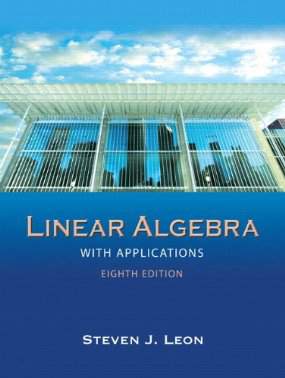Connecting...

This is a quick preview of the lesson. For full access, please Log In or Sign up.
For more information, please see full course syllabus of Linear Algebra
For more information, please see full course syllabus of Linear Algebra
Linear Algebra Matrix of a Linear Map
Lecture Description
We’ll now show you how to represent a linear mapping as a matrix. You can think of this matrix as being made up of 3 different vectors, all of which are explained and demonstrated in this video. The procedure for finding this matrix is relatively straightforward like most other procedures in this course so long as you have a good understanding of previous topics like transformations. After watching this video and after you understand the material you will have successfully completed the course on linear algebra!
Bookmark & Share
Embed
Share this knowledge with your friends!
Copy & Paste this embed code into your website’s HTML
Please ensure that your website editor is in text mode when you paste the code.(In Wordpress, the mode button is on the top right corner.)
×
Since this lesson is not free, only the preview will appear on your website.
- - Allow users to view the embedded video in full-size.
Next Lecture
Previous Lecture










































 Answer Engine
Answer Engine




1 answer
Thu May 1, 2014 9:24 PM
Post by Josh Winfield on April 21, 2014
I thank you for every hour, minute and second you spent understanding these concepts, so you could explain it simply to us and inspire a love for mathematics and a sense of intuition that will only continue to grow. Cheers Raffi, thanks Chief.
1 answer
Fri Mar 28, 2014 5:46 PM
Post by Hoa Huynh on March 23, 2014
Dear Professor,
At 24:30, you said A(nat basis) = [(1,0), (1,0), (0,-1)]. I do not get where it comes from. Please, explain me
0 answers
Post by Manfred Berger on June 25, 2013
Thank you, I'll see you, quite literally in Multivariate Calculus
1 answer
Tue Sep 11, 2012 12:23 AM
Post by Ian Vaagenes on September 10, 2012
Hi Raffi,
Great course, any change we'll get a lecture on singular value decomposition?
Best,
Ian
0 answers
Post by Shahaz Shajahan on August 24, 2012
Hi, sorry to be a pain but I have sent another question on the facebook page, if you can just look at it for me please, thank you
1 answer
Wed Aug 15, 2012 6:17 PM
Post by Brendan Hu on August 15, 2012
I watched all of your lectures this summer and I've learned so much. As Peter has, I just wanted to express my gratitude. I've talked to my dad of your knowledge of and passion for math, and we both agree that we wish we saw teachers like you more often. I also feel (and hope) that it was a great preparation for my Linear Algebra class at Berkeley in the Fall. Thanks so much Dr. Hovasapian :)
1 answer
Thu Jul 26, 2012 12:55 AM
Post by Hengyao [Peter] Han on July 25, 2012
I really cant express how useful your lectures were to me, I really wouldn't do well in my class if I never found your lectures on this site. It's so worth it. Thank you so much Professor Hovasapian!